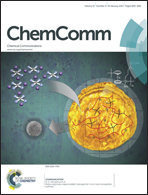Switching intermolecular interactions by confinement in carbon nanotubes†
Abstract
The encapsulation of trityl-functionalised C60 molecules inside carbon nanotubes drastically affects the intermolecular interactions for this species. Whilst the orientations of molecules in the crystal are often controlled by thermodynamics, the molecular orientations in nanotubes are a result of kinetic control imposed by the mechanism of entry into and encapsulation within the nanotube.


 Please wait while we load your content...
Please wait while we load your content...